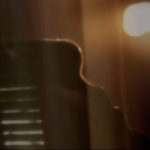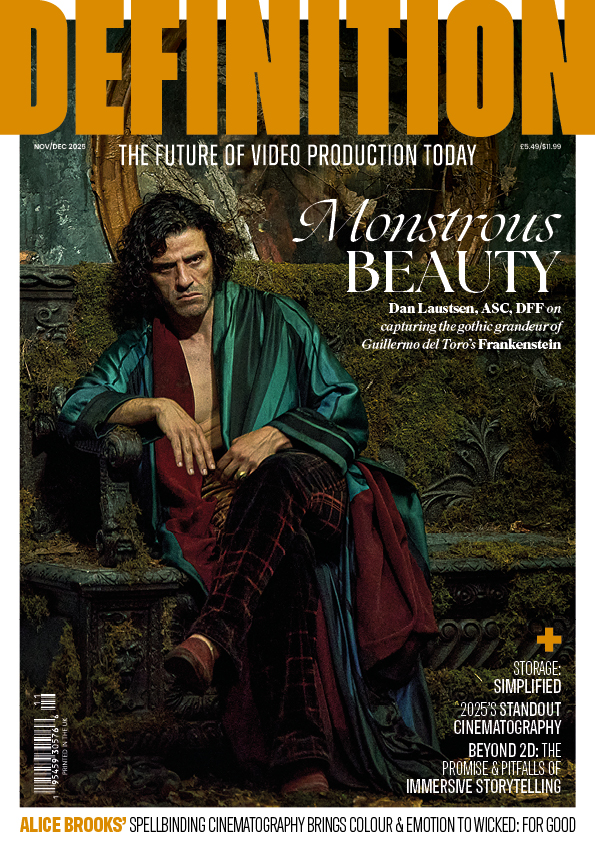
Out Of The Dark Ages
Posted on Mar 26, 2010 by Alex Fice
Test image shot with RED Mysterium-X at ISO 800 (graded for look). The double-appearance of the candles on the far left comes from a filter we tested (and decided against).After shooting 2012 with Panavision’s Genesis, we began searching uncharted territory for an upcoming feature film project that had a considerably lower budget. Most of the film would be shot in low-light scenarios, and lots of scenes, again, would play in front of blue or green screen. So we knew that we needed a low-grain, high-sensitivity recording solution. My digital compositors, and me personally, have preferred digital noise over film grain for a long time. But not every Director of Photography would think the same way. Some because they’re simply afraid of working in a different medium than they had been for the past decades, and others for more valid reasons like, for instance, dynamic range.
We started testing the RED One with the new Mysterium-X sensor, which has been shipping for a few weeks now, and then the ARRI ALEXA joined the race. The ALEXA is currently a prototype and scheduled to ship in mid-June of this year.
Now, because I’m so excited about what I saw, I’ll give you the test results upfront.
Digital has finally won over film. Yes, for me the most important outcome of this test was not one or the other camera, but that BOTH finally made it possible for me to say this: “FILM (Celluloid, that is), IS DEAD!”
Let me start with a disclaimer here, because I know there will be a mass of hate mail from 35mm film lovers landing on my doorstep very soon. Since I don’t have the time to answer any of it, I would rather like to pre-empt it right now. I have no agenda here. I started out using 8mm film as a teenager, I shot 35mm (and 16mm) film for years and years, I don’t work for a company selling digital equipment of any kind, and I don’t get kick-backs from any such company. But I stick to what I just said. Film is dead.
Film has been in the death throes for a few years by now, as a small part of a huge revolution that has seen ‘digits’ taking over all aspects of our lives. It started in general with computers (anyone using a typewriter right now?), then expanded to other usage areas (anyone listening to 45rpm records right now? Actually, how many of you are even still listening to CDs rather than mp3s?). I don’t think I have to remind anyone that we ALL used to shoot on 35mm still cameras up to the mid-nineties, give or take a few years. And how many of you are still making the trek to the drugstore to have the photos from the last kid’s birthday party developed ?
Then came digital projection systems. Currently, 15% of the world’s screens (over 16,000) are already digital, with growth rate of between 250-280% in many regions. Then digital TV, which is taking over as a standard (in different versions) worldwide. Then DI (Digital Intermediate). There’s no movie currently produced by a major Hollywood studio that does NOT have a DI and/or digital colour correction. Even Quentin Tarantino, who loathes anything digital, does a DI now.
Now back to shooting digital. It has been creeping forward, but has not taken over yet. I hear rumours of die-hards that actually shoot 16mm and use a digital de-graining process to prop up the sub-standard footage, rather than shooting digital. Please get real.
There have been lots of arguments flying back and forth, and in the past there were still a bunch of valid arguments for shooting film. Not anymore. After testing the ARRI ALEXA and RED Mysterium-X, I believe there are no valid arguments left. And I will explain why.
The only valid argument is for film as archival medium. The process (that only high-budget productions can afford), in which the red, blue and green ‘channel’ are recorded onto black and white film stock makes sense still, since there is no valid and safe alternative for long term storage of digital material yet. But as a recording and playback format, digital is more stable (only a 4-pin 35mm could come close), has less noise than film has grain, and it is cheaper (both in terms of stock, ‘developing’, dailies creation and printing). It takes less space. If you have an entire digital workflow (like we had on 2012), you can have 100% colour accuracy from the on-set monitor to the DCP (which you could never have with any analogue format). If you want high-speed, use the Vision Research Phantom camera, and you’ll have immediate playback (or an entire day later with a 35mm high-speed camera). You can get the same depth of field as 65mm film on certain cameras, if you like. Your sound can be synched on set, editorial can start editing after a few hours of shooting. With a good quality control pipeline, you can get an OK for your footage a few hours after you have shot it. You can see your image on set on a high resolution, colour corrected monitor. You can do visual effects overlays or live keys in full resolution on set. On top of all that, you can save anywhere from $50,000 on a low budget movie, to half a million on a high budget picture, in the process.
The only reason left for shooting film was that digital cameras did not have the same dynamic range 35mm film could provide.
Not anymore!
To be honest, I never thought the dynamic range discussion was a valid reason. Just look at the final result. It’s hardly a reason to baulk at two stops less than film, if a theatrical print made in a high-speed printing process has at best seven stops dynamic range, and your TV (that goes for DVD and Blu-Ray as well, of course) only displays 8-bit colour. But anyway, if that’s your only reason, it’s gone. The dynamic range of these two cameras blew me away. ARRI has measured 13.5 stops. What we found seemed to support that. Which brings me finally to our test.
Our Director of Photography, Anna Foerster, had never shot a complete movie digitally, but she was very intrigued by the subject. For someone coming straight from the ‘celluloid world’, there are two questions that are most important. The dynamic range and the colour reproduction.
 fig 1: The daylight comes from a 4K and 6K HMI, bounced through the window. There’s a 400W HMI source as interior fill, and a 12×12 muslin on the right, as a bounce for the window light. This image was shot with the ARRI Alexa, at ISO 800. It has been graded for look.
fig 1: The daylight comes from a 4K and 6K HMI, bounced through the window. There’s a 400W HMI source as interior fill, and a 12×12 muslin on the right, as a bounce for the window light. This image was shot with the ARRI Alexa, at ISO 800. It has been graded for look.
 fig 1: The same image, graded four stops under. All the highlight detail in the window is preserved.
fig 1: The same image, graded four stops under. All the highlight detail in the window is preserved.
 fig 1: The same image, graded two stops over. A lot of detail in the dark areas (hair, fabric and back walls) is visible, at low grain.
fig 1: The same image, graded two stops over. A lot of detail in the dark areas (hair, fabric and back walls) is visible, at low grain.
fig 1: Take a look at these images: The daylight comes from a 4K and 6K HMI, bounced through the window. There’s a 400W HMI source as interior fill, and a 12×12 muslin on the right, as a bounce for the window light
The RED had slightly less dynamic range than the Alexa. I would put the RED rather in the range of 11-12 stops usable range, which is still excellent. I’ve heard of other test shoots for the RED coming in at 13 stops, and that may be true, too. But in direct comparison, we could see detail in the blacks of the ARRI footage that was gone in the RED, and the same with highlights. But, as I mentioned before, I believe none of this practically matters much, unless your DP grossly over or under exposes, which would be pretty much impossible if you have a calibrated monitor on set.
For colour negative film, the ISO/ASA rating is defined as a particular point on three D-Log H curves (for red, green and blue). This point, in short, determines the film stock’s sensitivity to light.
Digital sensors are a bit more flexible than film stock. Their sensitivity to light can be changed by setting the signal gain (Read: The input power). So digital still cameras use exposure indexes (that are created by addition or deduction of gain) that are similar to film’s ISO ratings and thus are marked as ‘ISO’ on the camera. Some HD cameras, like the Sony F-900, for instance, have a certain sensor rating (ISO300 for the F-900) and let you adjust the gain in dB increments, effectively changing the ISO. However, you have to be careful, as many digital cameras’ exposure latitude decreases when set to a higher or lower sensitivity than their native sensitivity. On top of that, digital cameras let you adjust the shutter past 180 degrees (270 and 360 degrees, which equals no shutter), which again doubles and quadruples the ISO, respectively.
RED quotes the Mysterium-X sensor as ISO 320-2000. Anna, the DP, measured during our test with a light meter. Jonathan Smiles, our Digital Production Supervisor, who has worked on several movies shot with RED, including District 9, set the F-Stop and metadata settings according to Anna’s light meter settings (we used 800 and 1280 ASA as a basis, and then also under-exposed by several stops for testing purposes).
Since the ARRI ALEXA is a prototype, not all of the features that will be in the release version, announced for June this year, were available to us. The release version will have an (as yet unspecified) on board recording solution. I think that’s not only a good idea, but a MUST, since the ARRI D-21 does not have any dockable recording options, like, for instance, the Genesis or Sony’s F-23 and F-35. ARRI RAW recording was not available to us yet, so we used the dual-link HD-SDI (4:4:4) signal coming from the camera. We chose to record on CODEX digital portable recorders. The CODEX portables record internally to JPG2000 format file sequences (which is also the standard for DCDMs (Digital Cinema Distribution Master), the current standard for digital cinema projection). The JPG2000 files sport a 1:4 compression, basically the same as Sony’s internal hardware compression when you record to HDCamSR tape at its normal 440Mbit/s rate.
We recorded the Red One footage to CF cards, at 42MB/s. We converted all the footage for post production via the REDCine-X (beta) software. The size per frame (at 24fps) is roughly the same, 1.75MB for RED (.r3d files) and 2MB for Codex-recorded JPG-2000 files. But the RED compression ratio is higher than the ARRI because of the bigger frame size. So as was expected, the RED shows more compression artifacts than the ARRI, especially in the higher-grain blue channel, but nothing out of the ordinary. We didn’t see any ‘clumped together’ chunks of pixels, as might happen when pictures get over-compressed.
The low noise level on both cameras absolutely blew me away. Just for kicks, we exposed up to four stops under from a base of ISO800, so the equivalent of 12,800 ASA. Even after seeing all footage on the big screen (we projected digitally, and filmed out to 35mm), I still think that ISO 3200, with some digital noise reduction in post, is absolutely feasible on BOTH cameras.
 fig 2 – A blow-up of an image section of the ARRI ALEXA, pushed 2 stops in grading, the equivalent of ISO 3200! The noise level is absolutely acceptable.
fig 2 – A blow-up of an image section of the ARRI ALEXA, pushed 2 stops in grading, the equivalent of ISO 3200! The noise level is absolutely acceptable.
fig 2 is a blow-up of an image section of the ARRI ALEXA, pushed two stops in grading, the equivalent of ISO 3200! The noise level is absolutely acceptable.
In the RED M-X footage, the blue channel has the worst grain, then red, then green (which is to be expected, because of Bayer array interpolation). The ALEXA showed, surprisingly, less of a difference between the three channels, but still with the green channel being least noisy. One reason for that might be the sensor’s pixel size. Generally, the larger the sensor’s pixel size, the lower the noise. Digital SLRs, for instance, have generally lower noise (and pixel sizes of about 6.8 microns and up) than compact digital cameras (with a sensor size of around 3.5 microns or lower). ALEXA’s ALEV-III sensor has a pixel size of 8.25 microns, which I’m guessing is bigger than the Mysterium-X’s (for which I couldn’t find any data), since RED has to cram more pixels into the same space.
 fig 3 – An extreme example: A blow-up of RED M-X footage exposed at ISO 12,800! I think the low noise level is absolutely amazing!
fig 3 – An extreme example: A blow-up of RED M-X footage exposed at ISO 12,800! I think the low noise level is absolutely amazing!
fig 3 – An extreme example: A blow-up of RED M-X footage exposed at ISO 12,800! I think the low noise level is absolutely amazing. Even this would still be usable, with a digital noise reduction applied, at least for documentary-style projects.
Other observations we made were that the ARRI ALEXA footage was generally softer (part of that is obviously because of the different resolutions between the two cameras, which makes them tougher to compare). ARRI’s sensor has a resolution of 2280×1620 pixels, downrez’d internally to 1920×1080. We actually liked the slightly softer look; it did seem film-like, since the edge sharpening is usually a give-away for broadcast video cameras. But RED M-X’s recording of 4480×1920 pixels (a cinemascope-like aspect of 2.33:1) does have the advantage of displaying slightly more fine detail. After looking at lots of different areas in the picture, we noticed, though, that resolution and detail-behaviour is very hard to pinpoint. For instance, if you sharpen an image only slightly, it gives the ILLUSION of more detail, so it’s easy to have a difference of opinion with many people in the screening room.
In terms of colour reproduction, the ARRI was slightly ahead of the RED. In the low light areas, we found slight colour shifts into magenta or green with the RED, while the ALEXA showed a stable reproduction of the brown wall. A similar effect happened in the gradient areas where the light streaming in from the window falls off into darkness. In some situations, the RED showed a rainbow-like array of colours, while the ARRI showed a straight gradient from white to brown. But both of these effects only become visible when playing around with the colours and lifting the gain in DI. The RED – and this could be due to the higher compression – shows a tendency to ‘flip’ colours faster than the ARRI. For example, if you correct the hues and try to take out just a slight amount of green, the RED footage would flip faster towards magenta than the ALEXA footage.
We noticed an interesting effect when light sources (in our case candles) come close to the lens. We tested the same lens on both cameras, to make sure that it’s not caused by the lens, but only the RED showed a soft red blooming effect that we were guessing might stem from the Optical Low Pass filter (OLPF). We sent the footage to the guys from RED, and they’re currently investigating.
 fig 4 – Another advantage of very low noise: Clean keys. This green screen, shot with the ARRI ALEXA at ISO 800, keeps all important details in the transparent and hair areas. Original (raw, ungraded) image of the Alexa above, keyed, graded image below
fig 4 – Another advantage of very low noise: Clean keys. This green screen, shot with the ARRI ALEXA at ISO 800, keeps all important details in the transparent and hair areas. Original (raw, ungraded) image of the Alexa above, keyed, graded image below
 fig 4 – Another advantage of very low noise: Clean keys. This green screen, shot with the ARRI ALEXA at ISO 800, keeps all important details in the transparent and hair areas. Original (raw, ungraded) image of the Alexa above, keyed, graded image below
fig 4 – Another advantage of very low noise: Clean keys. This green screen, shot with the ARRI ALEXA at ISO 800, keeps all important details in the transparent and hair areas. Original (raw, ungraded) image of the Alexa above, keyed, graded image below
fig 4 – Another advantage of very low noise: Clean keys. This greenscreen, shot with the ARRI ALEXA at ISO 800, keeps all important details in the transparent and hair areas.
After three days of testing, I’m convinced that these two cameras (or, to be accurate, their sensors) are a huge step ahead for digital cinematography and open up new possibilities we’ve only dreamt of before. I’m sure other manufacturers will soon follow suit. And with higher resolution sensors and projectors already announced and in development, our cinematic future is bright, sharp and with very low noise…
Marc Weigert is an Emmy-award winning visual effects supervisor and producer. He is the CEO of Uncharted Territory in Los Angeles, founded in 1999 with business partner Volker Engel. Under the ‘Uncharted’ banner he has produced and co-produced several TV movies, mini-series and feature films, most notably Roland Emmerich’s 2012 and Dean Devlin and Bryan Singer’s The Triangle. Marc is currently co-producing and VFX supervising Emmerich’s Anonymous
Link to HD Magazine’s version of this article with full screen shots








